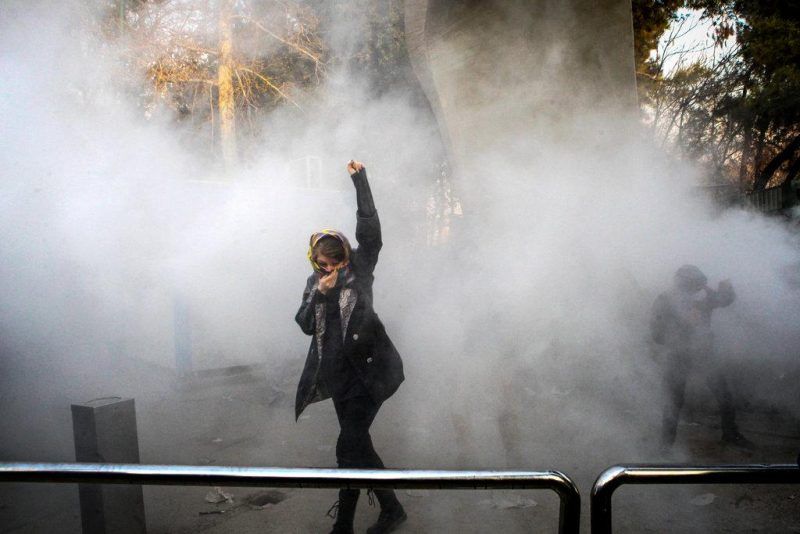
As anti-government rallies gather momentum across Iran — taking outside analysts and the Iranian government alike by surprise — President Trump and his foreign policy advisers are likely asking what they can do to support the protesters.
Mr. Trump, after all, has said Iran is responsible for nearly all the problems of the Middle East, and accuses the country of spreading “death destruction and chaos all around the globe.” The president would no doubt love to announce that his tough approach has delivered results by undermining the repressive Iranian government, and that his predecessor’s more conciliatory approach failed.
I, too, want to see the government in Tehran weakened, moderated or even removed. So let me offer Mr. Trump some unsolicited advice: Keep quiet and do nothing.
On Friday night and again on Saturday, Mr. Trump sent out tweets calling on the Iranian government to “respect their people’s rights” and warning that “The world is watching!” That’s more than enough. At this stage, we have little idea what these protests are really about or where they will lead. But we can be fairly certain that high-profile public support from the United States government will do more harm than good.
I realize this advice goes against the president’s instincts, given the centrality of Iran to his agenda and his unquenchable desire to claim credit for anything positive that happens on his watch.
Many top Trump administration officials have long insisted that the only path to true change in Iran — and the best way to deal with Iran’s support for terrorism and its potential nuclear weapons program — would be for regime change. In his Oct. 13 declaration “decertifying” the nuclear deal to Congress, the president suggested the Iranian people rise up and “reclaim their country’s proud history.” On Friday, the State Department reiterated Secretary of State Rex Tillerson’s support for those in Iran seeking a “peaceful transition of government.” Sen. Tom Cotton, a Republican from Arkansas and an influential Trump adviser, has previously advocated covert action to “support internal domestic dissent.”
But if Iranians do choose to rise up and push aside their government, it will not be the result of support from Washington.
One reason to worry that Mr. Trump may try to seize the moment by championing the protesters is that it has become an article of faith among President Barack Obama’s critics than in 2009 he missed a golden opportunity to do just that, when many Iranians took to the streets after a disputed election result. But it was never clear what difference American rhetorical support would have made then, other than allowing the Iranian government to depict the protesters as American lackeys, giving the security services more of a pretext to crack down violently.
Even if Mr. Obama’s support might have somehow been helpful to the Iranian opposition, Mr. Trump’s almost certainly will not be. Whatever Iranians think of their own government, they are unlikely to want as a voice for their grievances an American president who has relentlessly opposed economic relief for their country and banned them from traveling to the United States.
In addition, Mr. Trump is now threatening to “terminate” the nuclear deal (breaking with European allies and the rest of the United Nations Security Council); unconditionally supports Iran’s biggest adversaries, Saudi Arabia and Israel; and recently recognized Jerusalem as Israel’s capital, a move rejected by every other country in the region. His policies are dividing the United States from its international partners and giving Iranians reasons to unite against him. A smarter strategy would be designed to do the opposite.
To the extent that these protests are a sign of the Iranian public’s discontent with its leaders, they also belie Mr. Trump’s argument that the nuclear deal provided “urgently needed relief from the intense domestic pressure the sanctions had created,” as he put it in his October speech. On the contrary, while providing Iran some real economic benefits, the implementation of that deal over the last two years has also taken away the Iranian government’s ability to blame the United States for Iran’s enduring economic woes.
If Mr. Trump blows up the deal and reimposes sanctions, he will not be doing the opposition a favor but instead giving Iranians a reason to rally to — rather than work against — the government they might otherwise despise.
The protests taking place in Iran today are perhaps a sign that, in the long run, the Iranian people want to be accepted as free, responsible members of the international community and that in time they might demand and achieve real change. The best way for Mr. Trump to help test that proposition and increase the chance of its success is to do nothing.
Philip Gordon is a senior fellow at the Council on Foreign Relations. He was an assistant secretary of state and White House coordinator for the Middle East during the Obama administration.
